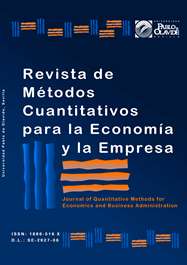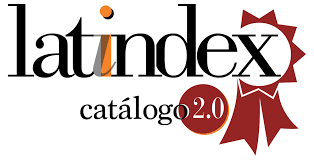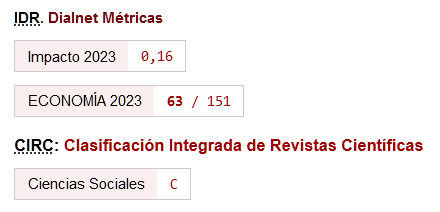Methodology for composite index construction: contributions from the Departmental Competitive Potential Index for Uruguay
DOI:
https://doi.org/10.46661/rev.metodoscuant.econ.empresa.6592Keywords:
Composite indicators, Methodology, Competitiveness, UruguayAbstract
The objective of the article is to carry out a review of the subject of composite indicators, especially that related to the methodological process associated with their construction, detailing and discussing the various steps linked to said process, using the construction of the Competitive Potential Index Departmental (IPCD) as a reference., an indicator that measures the competitive potential of the Departments (administrative regions) in Uruguay, in order to show a specific case and the options that were taken in its construction, without going into the detailed explanation of said indicator. The main reflection that should be highlighted is the need for transparency in the construction of the index. That is, the strength of the composite index and its usefulness in the future will depend directly on the quality of the information and the justification provided for each of the decisions made by the researcher (or research team) in charge of building the index.
Downloads
References
Aiginger, K. (2006). Competitiveness: from a dangerous obsession to a welfare creating ability with positive externalities. Journal of Industry, Competition and Trade, 6(2), 161-177.
https://doi.org/10.1007/s10842-006-9475-6
Aiginger, K. y Firgo, M. (2015). Regional competitiveness under new perspectives. Recuperado de: https://ideas.repec.org/b/wfo/wstudy/58501.html
https://doi.org/10.2139/ssrn.2685585
Aiginger, K. y Firgo, M. (2017). Regional competitiveness: connecting an old concept with new goals. En R. Huggins y P. Thompson (Eds.), Handbook of Regions and Competitiveness: Contemporary Theories and Perspectives on Economic Development (pp. 155-191). Northampton: Edward Elgar Publishing, Inc.
https://doi.org/10.4337/9781783475018.00013
Becker, W., Saisana, M., Paruolo, P. y Vandecasteele, I. (2017). Weights and importance in composite indicators: closing the gap. Ecological Indicators, 80, 12-22. https://doi.org/10.1016/j.ecolind.2017.03.056
Camacho, M. (2020). Competitividad, bienestar y ciudades. Pontificia Universidad Católica Argentina. Buenos Aires.
Curchod, M. A. y Alberto, C. L. (2021). Cálculo de un indicador multicriterio para la gestión de recursos humanos y tecnológicos en un servicio de hemodiálisis. Revista de Métodos Cuantitativos para la Economía y la Empresa, 32, 49-65. https://doi.org/10.46661/revmetodoscuanteconempresa.4195
Deas, I. y Giordano, B. (2001). Conceptualizing and measuring urban competitiveness in major English cities: an exploratory approach. Environment and Planning A, 33(8), 1411-1429. https://doi.org/10.1068/a33142
Decancq, K. y Lugo, M. A. (2013). Weights in multidimensional indices of wellbeing: An overview. Econometric Reviews, 32(1), 7-34. https://doi.org/10.1080/07474938.2012.690641
Domínguez Serrano, M., Blancas Peral, F., Guerrero Casas, F. y González Lozano, M. (2011). Una revisión crítica para la construcción de indicadores sintéticos. Revista de Métodos Cuantitativos para la Economía y la Empresa, 11, 41-70. https://doi.org/10.46661/revmetodoscuanteconempresa.2094
El Gibari, S., Gómez, T. y Ruiz, F. (2019). Building composite indicators using multicriteria methods: a review. Journal Business of Economics, 89, 1-24. https://doi.org/10.1007/s11573-018-0902-z
EUROSTAT (2018). European Statistics Code of Practice. EUROSTAT.
Freudenberg, M. (2003). Composite indicators of country performance: A critical assessment. OECD Science, Technology and Industry Working Papers. Paris: OECD Publishing.
Greco, S., Ishizaka, A., Tasiou, M. y Torrisi, G. (2019). On the methodological framework of composite indices: A review of the issues of weighting, aggregation, and robustness. Social Indicators Research, 141, 61-94. https://doi.org/10.1007/s11205-017-1832-9
Huggins, R., Izushi, H. y Thompson, P. (2013). Regional competitiveness: theories and methodologies for empirical analysis. Journal of CENTRUM Cathedra: The Business and Economics Research Journal, 6(2), 155-172.
IMCO (2018). Califica a tu alcalde: Manual urbano para ciudadanos exigentes. Índice de Competitividad Urbana. Instituto Mexicano para la Competitividad (IMCO). Recuperado de: http://imco.org.mx/indices/calificaa-tu-alcalde/
Jiang, Y. y Shen, J. (2013). Weighting for what? A comparison of two weighting methods for measuring urban competitiveness. Habitat International, 38, 167-174.
https://doi.org/10.1016/j.habitatint.2012.06.003
Jiménez-Fernández, E., Sánchez, A. y Ortega-Pérez, M. (2022). Dealing with weighting scheme in composite indicators: An unsupervised distance-machine learning proposal for quantitative data. Socio-Economic Planning Sciences, 83, 1-11. https://doi.org/10.1016/j.seps.2022.101339
Kelley, J. D. y Simmons, B. A. (2015). Politics by number: Indicators as social pressure in international relations. American Journal of Political Science, 59 (1), 55-70. https://doi.org/10.1111/ajps.12119
Kuc‑Czarnecka, M., Lo Piano, S. y Saltelli, A. (2020). Quantitative Storytelling in the Making of a Composite Indicator. Social Indicators Research, 149, 775-802 https://doi.org/10.1007/s11205-020-02276-0
Lafuente, E., Araya, M., Leiva, J.C. (2020). Assessment of local competitiveness: a composite indicator analysis of Costa Rican counties using the “Benefit of the Doubt” model. Socio-Economic Planning Sciences, 81, Article 100864, 10.1016/j.seps.2020.100864
Munda, G. y Nardo, M. (2009). Noncompensatory/nonlinear composite indicators for ranking countries: a defensible setting. Applied Economics, 41(12), 1513-1523.
https://doi.org/10.1080/00036840601019364
Nardo, M. y Saisana, M. (2009). Handbook on constructing composite indicators. Putting theory into practice. OECD.
Nardo, M., Saisana, M., Saltelli, A., Tarantola, S., Hoffman, A. y Giovannini, E. (2005). Tools for Composite Indicators Building. EUR 21682 EN. 2005. JRC31473.
OCDE (2008). Handbook on constructing composite indicators: methodology and user guide: OECD publishing. OECD.
Porter, M. (1990). The competitive advantage of nations. Harvard business review, 68(2), 73-93.
https://doi.org/10.1007/978-1-349-11336-1
Saisana, M. y Saltelli, A. (2011). Rankings and Ratings: Instructions for use. Hague Journal on the Rule of Law, 3(2), 247-268.
https://doi.org/10.1017/S1876404511200058
Saisana, M. y Tarantola, S. (2002). State-of-the-art report on current methodologies and practices for composite indicator development. ISSN 1018-5593, EU-NA-20408-EN-C.
Saisana, M., Saltelli, A. y Tarantola, S. (2005). Uncertainty and sensitivity analysis techniques as tools for the quality assessment of composite indicators. Journal of the Royal Statistical Society: Series A (Statistics in Society), 168(2), 307-323.
https://doi.org/10.1111/j.1467-985X.2005.00350.x
Sharpe, A. (2004). Literature review of frameworks for macro-indicators. Center for Study of Living Standards, Research Report 03.
Published
How to Cite
Issue
Section
License
Copyright (c) 2023 Dr. Roberto Horta, Dra. Micaela Camacho, Dr. Luis Silveira, Mag. Lucía Ferreira

This work is licensed under a Creative Commons Attribution-ShareAlike 4.0 International License.
Submission of manuscripts implies that the work described has not been published before (except in the form of an abstract or as part of thesis), that it is not under consideration for publication elsewhere and that, in case of acceptance, the authors agree to automatic transfer of the copyright to the Journal for its publication and dissemination. Authors retain the authors' right to use and share the article according to a personal or instutional use or scholarly sharing purposes; in addition, they retain patent, trademark and other intellectual property rights (including research data).
All the articles are published in the Journal under the Creative Commons license CC-BY-SA (Attribution-ShareAlike). It is allowed a commercial use of the work (always including the author attribution) and other derivative works, which must be released under the same license as the original work.
Up to Volume 21, this Journal has been licensing the articles under the Creative Commons license CC-BY-SA 3.0 ES. Starting from Volume 22, the Creative Commons license CC-BY-SA 4.0 is used.










